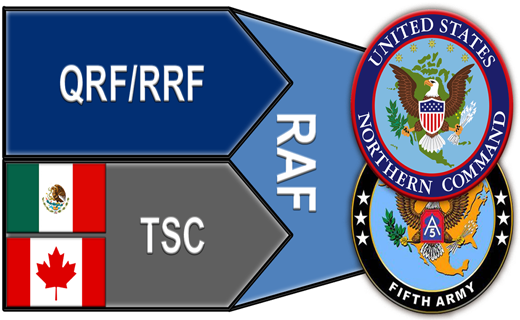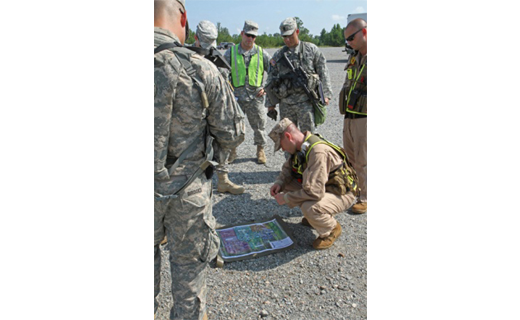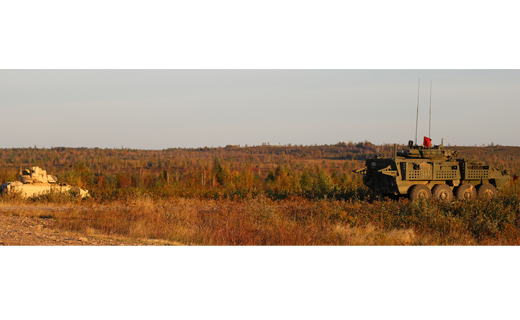Regional Alignment of a Brigade Combat Team to U.S. Northern Command



The Department of Defense Strategic Guidance for 2012 provided direction for the joint force of the future to become “smaller and leaner, but … agile, flexible, ready and technologically advanced.”1 With the imperative of a budget decrease and an uncertain international security environment, the U.S. Army implemented the regionally aligned forces (RAF) concept that balances efforts to prevent conflicts while maintaining readiness to defeat adversaries. The Army mans, trains and employs RAF to provide combatant commanders (COCOMs) with versatile, responsive and available Army forces. Regional alignment enables COCOMs with forces that provide capabilities to prevent, shape and win in today’s operational environment.
The 3rd Armored Brigade Combat Team, 3rd Infantry Division, led by COL Charles Costanza, was regionally aligned to Northern Command (NORTHCOM) March 1, 2014, to provide general-purpose forces supporting NORTHCOM through the Army North (ARNORTH) commander, LTG Perry Wiggins, as the quick-reaction force (QRF)/rapid-response force (RRF) and theater-security cooperation (TSC) mission sets. The brigade combat team (BCT)’s alignment to NORTHCOM marks the first time since the COCOMs’ inception that this mission was assigned to a single organization with parallel and common echelons of higher headquarters and reporting.
The brigade faced a unique set of new challenges while providing unprecedented levels of staff refinement and capability to the COCOM in execution of the assigned mission sets. Within each mission set, several lessons emerged to man, train and equip the brigade to fully meet the intent as the NORTHCOM RAF. These lessons included developing a shared understanding among multiple higher headquarters, balancing the requirements and priorities of multiple commands, and developing a system-based approach to handle emerging and no-notice missions.
Shared understanding
The most critical element of assuming the RAF mission focused on developing a shared understanding of the mission with multiple headquarters. The brigade maintained routine operational-control relationships to U.S. Army Forces Command (FORSCOM) until Army North (ARNORTH) requested forces to support NORTHCOM in an RAF capacity while maintaining traditional division and installation tenant-unit relationships. The multiple headquarters, with occasional divergent priorities, required the brigade leadership to achieve shared understanding through consistent messaging and unity of priorities, enabling pre-emptive mitigation of potential friction points over different equities.
Establishing direct-liaison authority (DIRLAUTH) allowed constant collaboration between 3/3 Infantry Division and ARNORTH to expand and identify opportunities on TSC efforts critical to shaping NORTHCOM’s area of operation and the implementation of QRF/RRF elements into joint exercises. Before mission assumption, the 3rd Infantry Division commander supported the RAF concept and the importance of the brigade, coordinating directly with ARNORTH by authorizing DIRLAUTH. The quick establishment of defining this command relationship promoted collaboration between the COCOM and FORSCOM to effectively man, train and equip forces seamlessly to maintain momentum with their theater partners.
The brigade achieved unity of effort through messaging based on a strong and consistent theme of priorities. To achieve consistent messaging, a level of transparency was required to share the message with all stakeholders. The brigade held a series of mission-assumption briefs to the ARNORTH commander, with participation from the division commander as well as representatives from FORSCOM. Brigade and subordinate leaders participated in RAF events by traveling to TSC locations and training events. Also, visits from ARNORTH leaders and staff and division support to emergency-deployment-readiness exercises (EDRE) and TSC events demonstrated the highest level of commitment to and involvement in the mission.
Concurrent to RAF operations, the brigade started an early knowledge transfer with the relieving unit anticipated to assume the mission from the brigade. Staff-visit exchanges occurred at several points during the mission and facilitated direct-counterpart communication, product-sharing and information exchange. Furthermore, the brigade maintained the intent to ensure that the following unit would be equipped with lessons-learned and advanced-planning timelines to ensure mission success. The aim behind developing an early dialogue and a shared understanding of the mission-set conditions was to maintain momentum of the progress the RAF had gained.
Ultimately, the cultivation of a comprehensive shared understanding among multiple headquarters enabled the brigade to manage competing requirements, maximize accomplishment of training objectives and maintain momentum that fully supported the NORTHCOM commander.
Manage priorities
The brigade faced several challenges balancing competing requirements from multiple headquarters. The brigade’s assigned mission was the NORTHCOM RAF, focused on providing three QRF/RRFs to rapidly deploy within the NORTHCOM area of operation and support security-cooperation missions with Mexico and Canada. However, while assigned, FORSCOM expected the brigade to maintain proficiency in decisive action (DA), including opportunities to participate in DA National Training Center rotations and for the brigade to reorganize to the Army 2020 force structure while executing the RAF mission.
The RAF concept, by design, requires a balance of training priorities between DA and mission-specific training. The ongoing reprioritization of DA focus creates the potential for a force to degrade or forget the lessons of counterinsurgency from recent conflicts. The RAF mission provides an opportunity to manage both to meet a shared endstate and an adaptable force. Both TSC and RRF/QRF missions require tactically and technically proficient formations to be trained and ready with respect to executing DA mission-essential task list (METL) tasks and training. Beyond DA training, these operations require the ability to interact with populations, demonstrate cultural respect and understanding, and maintain the ability to conduct non-lethal/non-kinetic targeting – key tenants of counterinsurgency doctrine. An effective RAF must manage both elements to achieve mission success.
The 3/3 Infantry Division established platoon-level proficiency as the qualification standard with respect to DA METL. Beyond platoon-level DA training, the brigade prioritized mission-specific individual training for key leaders and collective-training events focused on supporting NORTHCOM RAF requirements (Defense Support of Civil Authorities II, Mexico cultural/language training, EDREs, Vibrant Response/Vigilant Shield). The brigade’s mindset on training events became one of identifying and maximizing the overlap of DA-skills training within ARNORTH and RAF training events to maintain leader proficiency in essential tasks supporting unified land operations.
The level of balance required is ultimately determined by the type and scope of the assigned mission. Achieving that balance of priorities in the correct proportions results in “retention of tactical competence and technical proficiency while cultivating strategic perspective and leadership … educating and developing all Soldiers to grow the intellectual capacity to understand the complex contemporary security environment,” as the Army’s Chief of Staff envisioned with adaptive Army leaders and a globally responsive and regionally engaged force.2 The importance of managing priorities and projecting emerging tasks is critical to ensure a unit’s training readiness and effectiveness meet the RAF concept.
Systems approach
The rapid-response nature of the QRF/RRF and emerging TSC missions required a planning approach that was adaptable to different situations and readily employable on a reoccurring basis. The brigade developed a milestone-based systems approach focused on leveraging brigade and installation resources to support small-unit deployments and exercises.
- Develop the plan. The brigade developed simple and flexible D-Day/N-Hour models to ensure critical synchronization of administrative and logistical requirements with RAF missions. The development of modular-force packages to provide a menu of options to ARNORTH provided NORTHCOM a tailored capability while maintaining simplicity for unit readiness. Moreover, the brigade established a positive relationship with the installation that allowed the brigade to become more adaptable to the broad range of potential missions and essential tasks.
- Build the team. QRF/RRF elements required task-organization changes to meet force-package requirements. Multinational TSC missions represent a commitment by unit commanders to assume risk in routine operations to employ their best Soldiers in partnership. The QRF/RRF force packages are prescribed in ARNORTH Pamphlet 380-1, but with respect to mission command, the brigade was able to offer the COCOM mission-command packages scaled to fit the diversity of missions facing the RAF at the battalion and brigade level.
- Train the team. Each unit was required to execute platoon-level DA proficiency qualifications in addition to training RAF-specific skills. To train TSC missions, the brigade established Sledgehammer Academy to train all TSC personnel on critical skills (use of an interpreter, Mexican culture, Spanish-language training, etc.) by leveraging internal and external assets – specifically 162nd Infantry and the Western Hemisphere Institute for Security Cooperation. Subordinate units within the brigade conducted trained QRF/RRF collective training at the company level, focusing on RAF mission sets as a means to validate mission readiness and Soldier-level understanding of the mission. Leader-specific training events were conducted to maximize small-unit leader and staff-planner understanding of the NORTHCOM mission through Federal Emergency Management Agency (FEMA) Region IV defense-coordinating-officer visits and Defense Support of Civil Authorities Phase I and II training, as well as the required FEMA distance-learning course.
- Equip the team. QRF/RRF missions required equipment consolidation and contingency-stock management of materials, as well as transfers from external agencies to assemble mission-essential equipment lists (MEEL) to support the force packages. The brigade provided bottom-up refinement of the MEEL and identified shortfalls in requirements. The largest identified shortages outside of modified table of organization and equipment authorizations required sourcing from ARNORTH for TSC missions and external requests to division headquarters for communications systems. Situational awareness within NORTHCOM and the small team/company elements deployed away from battalion and brigade required vastly different communication systems from traditional tactical systems available to these small units.
- Maintain the team. No-notice/prepare-to-deploy orders and emerging TSC events required consistent monitoring and maintenance of deployment and training readiness; quarterly Soldier-readiness processing and EDRE events were critical to sustaining a viable force. By participating in ARNORTH training events and conducting quarterly EDRE exercises to off-site locations, the brigade was able to consistently refine and revalidate the state of readiness at the QRF level. To prepare for emerging and future TSC missions, the brigade maintained routine Sledgehammer Academy training to build capacity for future TSC missions as well as to maintain and improve critical skills.
The brigade received the NORTHCOM RAF mission a few months before mission assumption. This required the staff to develop a flexible plan promoting continued bottom-up refinement and improvement through coordination with higher headquarters. By establishing the plan early, subordinate units continued to refine the NORTHCOM RAF plan with each execution of a QRF/RRF or TSC mission over the course of a year. The comprehensive but generic approach allowed the planning and execution systems to be applied to most situations as well as passed on to the relieving organization for easy implementation and further refinement.
Conclusion
As the first BCT to be regionally aligned to NORTHCOM, 3/3 Infantry Division was faced with the problem of determining how a single unit should apply its efforts to best support the COCOM and achieve the endstate envisioned for an RAF.
The 3/3 Infantry Division achieved that endstate by generating Soldiers and organizations that are better trained for specific regions and providing the COCOM agile, adaptable and regionally focused general-purpose forces. The force alignment allowed strengthened relationships with other nations through partnered initiatives such as humanitarian, peacekeeping, border security, counternarcotics and counterterrorism efforts.
The brigade achieved this endstate by developing a shared understanding and clearly defined priorities at all levels. The culture of training within the Sledgehammer Brigade was one of developing true understanding of the requirements to conduct operations in the homeland, to the individual Soldier and small-unit leader level. This level of mission readiness was achieved by implementing a deliberate and systematic approach to executing every mission. Applying brigade- and battalion-level staff analysis and mission command to small-unit operations enabled these small-unit leaders to focus on the mission, knowing every echelon above was supporting their daily mission.
The 3/3 Infantry Division ultimately provided the ARNORTH and NORTHCOM staff with an unprecedented level of participation during their assigned year as the NORTHCOM RAF. As future BCTs assume the mission, provide refinement and conduct leader and unit training, the entire Army will develop into a more versatile and responsive force capable of preventing, shaping and winning in today’s operational environment.
Notes
1 Sustaining U.S. Global Leadership: Priorities for 21st-Century Defense, Washington, DC: Department of Defense, January 2012.
2 Waypoint #2: Follow-up to CSA’s Marching Orders, Washington, DC: Headquarters Department of the Army, February 2014.
 email
email print
print